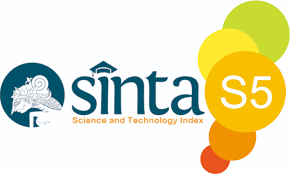Deteksi Gizi Buruk Pada Balita Menggunakan Metode Fuzzy Logic (Studi Kasus Puskesmas Kecamatan Semidang Alas Kabupaten Seluma)
Abstract
Nutrition plays a crucial role in maintaining health and well-being throughout the life cycle, especially in toddlers. Malnutrition can affect the physical growth, intelligence, and productivity of children. Factors such as economic conditions, parental attention, and unsupportive environments can contribute to cases of malnutrition in toddlers. Suboptimal monitoring of toddler development can increase the prevalence of malnutrition cases. This research aims to develop a Fuzzy Logic-based Decision Support System (DSS) application to detect malnutrition in toddlers, with a focus on the Semidang Alas Community Health Center in Seluma Regency. This study discusses variables for assessing malnutrition in toddlers, applies the Fuzzy Logic method to detect these conditions, and designs an application to diagnose malnutrition in toddlers. The research also includes community education on weight changes in malnourished toddlers and general nutritional status, providing input to improve services for malnourished toddlers. Assessment criteria involve the child's weight, height, and age, using Fuzzy Logic and DSS Application for data processing. Information handling related to malnutrition is limited to visible symptoms. Software development focuses on recognizing malnutrition diagnoses in children aged 0-5 years. A case study was conducted at the Semidang Alas Community Health Center using direct observation, nurse/midwife interviews, questionnaires, and literature reviews. System needs analysis used the Fuzzy Sugeno method. The malnutrition detection application was successfully built using Fuzzy Logic, providing detection results based on age, weight, and height. The defuzzification process produced detection values as a reference for further treatment. Application development involved both display and data aspects, with testing conducted with relevant parties to ensure the accuracy of detection results. User criticisms and suggestions provided valuable input for the improvement and development of this application.
Downloads
References
[2] M. Hermansyah and M. I. Mas’ud, “Penentuan Menu Makanan Dalam Pemenuhan Kebutuhan Kalori Buruh Pabrik Dengan Analisis Detak Jantung,” J. Rekayasa Sist. Ind., vol. 7, no. 1, p. 11, 2018, doi: 10.26593/jrsi.v7i1.2371.11-20.
[3] U. M. Rifanti, H. Pujiharsono, and Z. H. Pradana, “Implementasi Logika Fuzzy Pada Penilaian Kegiatan Merdeka Belajar Kampus Merdeka (MBKM),” JST (Jurnal Sains dan Teknol., vol. 12, no. 1, pp. 250–260, 2023, doi: 10.23887/jstundiksha.v12i1.50057.
[4] R. Noviani and S. Sulindawaty, “Sistem Pakar Mendiagnosa Gizi Buruk Pada Balita Menggunakan Teorema Bayes,” J. Nas. Komputasi dan Teknol. Inf., vol. 3, no. 2, pp. 163–169, 2020, doi: 10.32672/jnkti.v3i2.2383.
[5] R. D. Christyanti, D. Sulaiman, A. P. Utomo, and M. Ayyub, “Implementation of Fuzzy C-Means in Clustering Stunting Prone Areas,” Int. J. Nat. Sci. Eng., vol. 6, no. 3, pp. 110–121, 2022, doi: 10.23887/ijnse.v6i3.53048.
[6] S. Plowerita, A. S. Handayani, I. Hadi, and N. L. Husni, “Sistem Monitoring Kesehatan Dalam Penentuan Kondisi Tubuh Dengan Metode Fuzzy Mamdani,” PROtek J. Ilm. Tek. Elektro, vol. 8, no. 2, p. 102, 2021, doi: 10.33387/protk.v8i2.3341.
[7] R. P. W. Zahirah, M. N. Adiningtias, F. Millennianita, R. B. Sulistiaputri, and U. Athiyah, “Sistem Pendukung Pengambilan Keputusan Jumlah Produksi Barang Metode Fuzzy Tsukamoto,” J. Inform. dan Rekayasa Elektron., vol. 5, no. 2, pp. 181–190, 2022, doi: 10.36595/jire.v5i2.375.
[8] D. P. S. P. Sari, “Sistem Pendukung Keputusan Penentuan Status Gizi Buruk Pada Balita Menggunakan Metode Fuzzy Mamdani,” Edik Inform., vol. 2, no. 1, pp. 131–137, 2017, doi: 10.22202/ei.2015.v2i1.1454.
[9] R. A. Permata, D. Triyanto, and Ilhamsyah, “APLIKASI PENYUSUN MENU MAKANAN Abstrak,” J. Coding Sist. Komput. Untan, vol. 04, no. 2, pp. 96–106, 2016.
[10] R. P. Kushatmaja, “Rancang Bangun Perangkat Lunak Penghitung Kalori Dan Pengatur Pola Makan Pada Sistem Operasi Android,” Semnasteknomedia Online, vol. 5, no. 1, pp. 91–96, 2017.
[11] D. P. Alamsyah and I. H. Muna, “Metode Fuzzy Inference System untuk Penilaian Kinerja,” Sci. J. Informatics, vol. 3, no. 1, pp. 2407–7658, 2016.
[12] M. Utami and Y. Apridiansyah, “Implementasi Algoritma Sequential Searching Pada Sistem Pelayanan Puskesmas Menggunakan Bootstrap (Studi Kasus Puskesmas Kampung Bali Bengkulu),” JSAI (Journal Sci. Appl. Informatics), vol. 2, no. 1, pp. 81–86, 2019, doi: 10.36085/jsai.v2i1.166.
Copyright (c) 2024 Yuza Reswan, Yulia Darnita, A.R Walad Mahfuzhi, Yonaldo Putra

This work is licensed under a Creative Commons Attribution-ShareAlike 4.0 International License.
An author who publishes in Jurnal Media Infotama agrees to the following terms:The author holds the copyright and grants the journal the right of first publication of the work simultaneously licensed under the Creative Commons Attribution-Share Alike 4.0 License which allows others to share the work with acknowledgment of the work's authorship and initial publication in this journal.Submission of a manuscript implies that the submitted work has not been previously published (except as part of a thesis or report, or abstract); that it is not being considered for publication elsewhere; that its publication has been approved by all co-authors. If and when a manuscript is accepted for publication, the author retains the copyright and retains the publishing rights without limitation.
For new inventions, authors are advised to administer the patent before publication. The license type is CC-BY-SA 4.0.
MEDIA INFORMATION REVIEW: Journal of the Faculty of Computer Science is licensed under a Creative Commons Attribution-ShareAlike 4.0 International License.You are free to:Share
— copy and redistribute material in any medium or formatAdapt
— remix, modify and develop materialfor any purpose, even commercial.
The licensor cannot revoke this freedom as long as you follow the license terms












.png)


